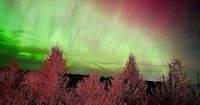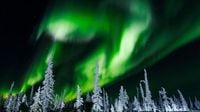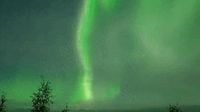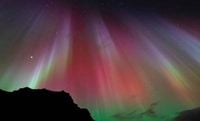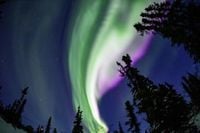A powerful burst of solar wind is interacting with Earth’s magnetic field tonight, March 25, 2025—potentially creating visible auroras across 15 U.S. states, according to space weather forecasts. As Forbes reports, the National Oceanic and Atmospheric Administration (NOAA) has issued a geomagnetic storm watch that could bring the northern lights well beyond their usual polar boundaries.
The geomagnetic storm was triggered by a coronal hole high-speed stream, a blast of charged particles emerging from a cooler, less dense region on the sun. This solar wind is currently interacting with Earth’s magnetic field, and when paired with a recent coronal mass ejection (CME), it is producing strong geomagnetic disturbances. NOAA’s three-day space weather forecast has placed the Kp index at 5 to nearly 6, on a scale that maxes out at 9. This level of activity typically pushes the auroral oval farther south from the Arctic, creating the conditions necessary for the northern lights to appear in skies much closer to the U.S. mainland.
The auroral display will be strongest across northern Canada and Alaska, but the southern view line may stretch into multiple U.S. states. States with a higher probability of visibility include northeastern Washington, northern Idaho, northern Montana, North Dakota, northern Minnesota, and upper Michigan. Regions with a lower likelihood—but still a chance, especially under dark skies—include Wyoming, South Dakota, Iowa, Wisconsin, New York, New Hampshire, Vermont, and Maine.
For best viewing, NOAA recommends heading out between 10 p.m. and 2 a.m. local time, far from city lights, and ideally from an elevated area. Photographers hoping to document the aurora should be prepared for low-light shooting conditions. According to National Geographic, using a tripod and a wide-angle lens is essential for stability and framing. Settings should favor long exposure: an F-stop of 4 or lower, high ISO, and a longer shutter speed will help reveal the colors invisible to the naked eye. Smartphone users should enable night mode and disable the flash to avoid washing out the image.
The current wave of solar activity is part of a broader pattern known as the solar maximum, the most active phase of the sun’s 11-year cycle. According to NASA, the latest solar maximum began building in 2024 and is expected to persist through early 2026. This cycle already produced a historic event in May 2024, when the strongest geomagnetic storm in two decades pulled the aurora as far south as Texas and northern Florida. That 2024 event marked the most powerful auroral display in 500 years, and tonight’s storm is another reminder of how space weather can light up our skies in unexpected places.
Auroras will be quite pleasing to look at as they move further away from the poles and become brighter," said a NOAA spokesperson. The excitement heightens with the approach of the spring equinox—a season when space weather experts note increased odds of clear visibility of the northern lights. The Russell-McPherron effect indicates that the chances of seeing auroras in March and September are about twice those seen during other seasons, according to the University of Alaska Fairbanks.
As skywatchers prepare for tonight’s spectacle, it’s worth recalling how solar activity achieved a peak with the latest solar maximum in October 2024. Solar activity during this cycle has significantly influenced the intensity and frequency of auroras, giving rise to not only aesthetic wonders but also occasional technology impacts from geomagnetic storms. "During a coronal mass ejection, the sun burps huge bubbles of electrified gas that can travel through space at high speeds," explains NASA. Such solar events create the conditions ideal for stunning displays that can brighten even the darkest winter nights.
As the evening approaches, those with clear skies should keep an eye out for the celestial dance. The anticipation is palpable, and for those fortunate enough to witness the display, it promises to be an unforgettable experience of nature's wonder. Prepare your cameras and gather your friends, as the night sky might turn into a canvas filled with vibrant colors—an awe-inspiring gift from the universe.
